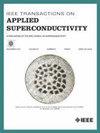Development of the Superlink HTS Cable System for Implementation in Munich
IF 1.8
3区 物理与天体物理
Q3 ENGINEERING, ELECTRICAL & ELECTRONIC
引用次数: 0
Abstract
The SuperLink Project develops, since 2020, a superconducting HTS cable technology suitable for the transmission of 500 MVA at the 110 kV level in the network of Stadtwerke München (SWM). A system consisting of a cable cryostat, the superconducting cable, joints, splitterboxes, terminations and a separate return line for the coolant has been developed and tested according to the specifications of the user and project coordinator SWM. It uses high-performing HTS wires, a fully polymeric cryogenic dielectric with low dielectric losses and a novel former concept compensating the thermal contraction. These components have been tested individually and together according to the test standard IEC 63075 and will be operated in the 150 m demonstrator of the project in the network of SWM. Due to limited availability of space in big-city environments, one utility requirement is to minimize the number of cooling stations along the length of a 15 km circuit in Munich. This demands very low loss-levels for the cable and cryostat and has required the development of novel cooling architectures and advanced electrical-, thermal- and hydraulic- modelling tools. Some of the modeling methods and key measured results are presented in this article.在慕尼黑实施的Superlink HTS电缆系统的开发
自2020年以来,SuperLink项目开发了一种超导高温超导电缆技术,适用于在Stadtwerke m nchen (SWM)网络中以110千伏水平传输500 MVA。该系统由电缆低温恒温器、超导电缆、接头、分离器盒、终端和冷却剂的单独回油管组成,并根据用户和项目协调员SWM的规格进行了开发和测试。它使用高性能高温超导导线,具有低介电损耗的全聚合物低温介质和补偿热收缩的新颖前概念。这些组件已根据测试标准IEC 63075单独或一起进行了测试,并将在SWM网络项目的150米演示器中运行。由于大城市环境的可用空间有限,一个公用事业要求是在慕尼黑15公里的线路上尽量减少冷却站的数量。这要求电缆和低温恒温器的损耗水平非常低,并且需要开发新型冷却架构和先进的电气、热和水力建模工具。本文介绍了一些建模方法和关键的测量结果。
本文章由计算机程序翻译,如有差异,请以英文原文为准。
求助全文
约1分钟内获得全文
求助全文
来源期刊

IEEE Transactions on Applied Superconductivity
工程技术-工程:电子与电气
CiteScore
3.50
自引率
33.30%
发文量
650
审稿时长
2.3 months
期刊介绍:
IEEE Transactions on Applied Superconductivity (TAS) contains articles on the applications of superconductivity and other relevant technology. Electronic applications include analog and digital circuits employing thin films and active devices such as Josephson junctions. Large scale applications include magnets for power applications such as motors and generators, for magnetic resonance, for accelerators, and cable applications such as power transmission.
 求助内容:
求助内容: 应助结果提醒方式:
应助结果提醒方式:


